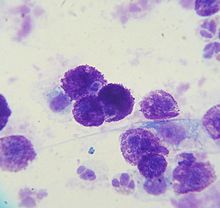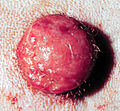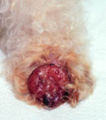Canine mast cell tumor
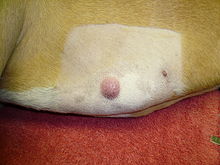
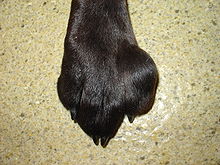
The mast cell tumor in dogs is a new formation ( neoplasia ) originating from mast cells in domestic dogs , which occurs mainly in the skin and subcutaneous tissue. Mast cell tumors are not only extremely common in dogs, but also tend to be malignant much more frequently than in other animal species. The mean survival time for malignant tumors is only four months, whereas for benign tumors it is over two years.
Mast cells are cells of the immune system that play a role in the innate immune response . They produce a number of biologically active substances, most notably histamine . Mast cell tumors make up about a fifth of all canine skin tumors. They show up as lumps or raised spots, ulcers and bleeding in the stomach and duodenum occur in around one fifth of affected animals . Daughter tumors in malignant mast cell tumors occur primarily in the lymph nodes , liver , spleen and bone marrow . Any lump in the skin or subcutaneous tissue can be a mast cell tumor. Detection is only possible by taking tissue with a fine cannula ( fine needle biopsy ) with subsequent staining and microscopic examination ( cytodiagnostics ).
Although the categorization according to the clinical symptoms and the cell structure in cytodiagnostics gives indications of the biological behavior (benign or malignant) and thus the prospect of a cure, this tumor disease is unpredictable and should be treated early. The method of choice is complete surgical removal , which may also be combined with radiation or chemotherapy . Tumors from which surgical removal is not possible or only incompletely possible can also be treated with tyrosine kinase inhibitors .
Mast cell tumors are also more common in domestic horses , ferrets and domestic cats , but they usually behave benign in these animal species. Mast cell tumors are very rare in other animal species and in humans.
Mast cell

Mast cells ( mastocytes ) are cells of the immune system and represent an important link between the innate and adaptive immune response . They arise from progenitor cells in the bone marrow and migrate as immature cells into many tissues , especially into those with close contact with the outside world, where they differentiate .
Mature mast cells are rounded cells in the connective tissue , the cytoplasm of which contains granules with different staining behavior ( metachromasia ). The granules are stored histamine , heparin and cytokines such as tumor necrosis factor-α . On the cell surface, mast cells have binding sites ( receptors ), two of which are functionally most important: The stem cell factor receptor ( tyrosine kinase KIT ) regulates the differentiation , reproduction , activation and lifespan of mast cells by binding the stem cell factor . The immunoglobulin receptor FcεRI ( high-affinity IgE receptor ) binds immunoglobulin E (IgE) with high binding strength ( affinity ). Not only the stem cell factor, but also a number of interleukins and ultraviolet radiation lead to activation and multiplication of mast cells. When mast cells are activated, inflammatory mediators , cytokines and proteases are either released from the granules or newly formed and released in a short time.
The function of mast cells in allergies is best researched; they are also involved in autoimmune diseases and in the intensification of the inflammatory reactions in bacterial infections . On the other hand, mast cells can also have anti-inflammatory effects as they protect against damaging factors such as bacteria and parasites . In addition, thanks to their large repertoire of biologically active substances, mast cells can contribute to the development and growth of other skin tumors.
Occurrence and origin
Mast cell tumors in dogs mainly occur in the skin and subcutaneous tissue. They are very rarely found in internal organs such as the small intestine , the oral mucosa , the nasal mucosa or the conjunctiva . About 20% of all skin tumors and 6% of all tumors in dogs are mast cell tumors. They occur more frequently in some breeds: German boxers and related short-headed breeds , golden retrievers , beagles , Irish setters , dachshunds and Bernese mountain dogs . There is no dependency on the sex of the animal. The mean age of affected dogs is eight years, but mast cell tumors can develop in dogs as early as four months old or at a very old age.
A number of mutations and chromosome changes are known in humans , which lead to the pathological multiplication of mast cells ( mastocytoses ). Mutations in the gene for the stem cell factor receptor (c-KIT) lead to a prolonged cell lifespan and an increased number of new mast cells. The D816V mutation is the most common of these c-KIT mutations and occurs in 80% of patients with mastocytosis. But there are also mastocytosis patients without changes in the stem cell factor receptor. In total, more than 20 chromosome changes are known in humans that can lead to mastocytosis, with chromosomes 2 , 7 , 12 , 13 , 14 and X most frequently affected.
Changes in c-KIT seem to play a role in dogs too. Both increased gene expression and a mutation with phosphorylation of the stem cell factor receptor, which leads to activation without binding of the stem cell factor ( ligand- independent), can occur. Meanwhile, such mutations are known more than 30, of which the most common a double ( tandem mutation ) of exon 11 is that the right on the inside of the cell membrane fraction lying (juxtamembrane domain ) of the stem cell factor receptor encoded . Mast cell tumors without a c-KIT mutation also occur in dogs; in contrast to US studies, almost no relevant c-KIT mutations were detected in mast cell tumors in German dogs. Whether this was coincidental or methodological, or whether it reflects genetic differences in the breeding lines, must be clarified through further investigations. The causes for the increased occurrence of mast cell tumors in dogs have not yet been clarified, presumably there are several causes (multifactorial occurrence).
Clinical picture

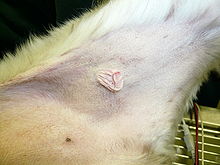
Mast cell tumors of the skin appear as nodules ( papules ), raised spots ( plaque ) or nodules ( nodus ), which can disintegrate on the surface as ulcers . Their consistency ranges from soft to rough-knotted. Redness and itching may occur locally ( Darier's sign ). Occasionally, satellite nodules appear , i.e. the tumor spreads via lymphatic vessels into adjacent skin areas; in about 10% of cases, several mast cell tumors are formed from the start ( primary multiplicity ).
Mast cell tumors can form daughter tumors ( metastases ) in the (regional) lymph nodes responsible for the area as well as in other organs such as liver , spleen and bone marrow ; other locations are very rare. In benign mast cell tumors, the metastasis rate is less than 10%, in malignant ones it is over 50%.
Even without the formation of daughter tumors, a mast cell tumor can trigger severe general disorders ( paraneoplastic syndrome ). These are triggered by the release of inflammatory mediators and cytokines. The formation of heparin by the mast cells can lead to an increased tendency to bleeding, as a result of the production of fibroblast- inhibiting cytokines (especially FGF-2 ) that interfere with wound healing processes . About one fifth of dogs with a mast cell tumor develop reluctance to eat, vomit , tarry stools and anemia as a result of gastric or duodenal ulcers ; such ulcers are even detected in over 80% of patients in autopsies . About 80% of dogs with such ulcers are euthanized due to their poor general condition . In particularly severe cases, these ulcers can lead to a life-threatening gastric or intestinal perforation . In addition, it can also lead to a clinical picture that is reminiscent of a malignant disease of the blood-forming system. This systemic mastocytosis is mainly observed in animals from which a mast cell tumor has previously been removed. Fatigue, unwillingness to eat, vomiting, weight loss, paleness, and enlarged liver and spleen occur.
According to the clinical picture, mast cell tumors are classified into four stages according to the criteria of the World Health Organization :
| Stage 1 | a tumor confined to the skin without lymph node involvement a) without general |
| Stage 2 | a tumor confined to the skin with lymph node metastasis a) without general |
| Stage 3 | Multiple tumors or large single tumors that grow infiltratively with or without lymph node involvement a) without general |
| Stage 4 | Tumor with distant metastasis or relapse with metastasis |
Diagnosis
A look or touch diagnosis is not possible, since neither appearance nor consistency allow a distinction to other skin tumors.
The diagnostic agent of choice is the fine needle biopsy , as sufficient cells can be obtained from mast cell tumors. In the cytological preparation , mast cells can be differentiated relatively easily from other cell types due to their granules , although it should be noted that certain rapid staining solutions only stain mast cell granules unreliably and cells of poorly differentiated mast cell tumors can contain very few granules.
In blood count changes are observed only rarely, occasionally, an increase of a subtype of white blood cells ( eosinophilia ) occur. With systemic mastocytosis, a decrease in the number of white blood cells ( leukopenia ) is common. Mast cells circulating in the blood are mostly not observed.
According to the histopathological cell picture, mast cell tumors in dogs are divided into different grades. The most widespread classification of mast cell tumors is based on the scheme by Patnaik and co-workers from 1984:
| Tumor grade 1 (well differentiated) | |
| Tumor grade 2 (moderately differentiated) |
|
| Tumor grade 3 ( anaplastic ) |
|
A study from 2011 questions this classification, however. Identical specimens from 95 mast cell tumors, of which the outcome of the disease was known, were sent to 28 pathologists in 16 different institutions. While the agreement between the various investigators was 75% for grade 3 tumors, it was less than 63% for grades 1 and 2, and the prognoses derived from this showed little agreement with the outcome of the disease. Kiupel and co-workers therefore proposed a new system that only provides for two grades: low-grade and high-grade . Tumors are classified as high-grade if one or more of the following criteria are met in ten fields of view at high magnification (40x objective ):
- at least seven mitoses
- at least three multinucleated cells (three or more cell nuclei)
- at least three abnormal nuclei (indentations, segmentation, irregular shape)
- Nuclear enlargement ( karyomegaly , the nucleus diameters of 10% of the mast cells vary by at least two times ).
The mean survival time in animals with high-grade mast cell tumors was four months, compared with two years in animals with low-grade mast cell tumors. In addition, recurrences and metastases were significantly more common in high-grade mast cell tumors. In addition, there seems to be a connection between the type of c-KIT mutation on the one hand and the biological behavior or the degree of tumor on the other. The immunohistochemical detection of cell division markers such as Ki-67 or the argyrophilic nucleolus organizer region (AgNOR) also shows correlations with the biological behavior of mast cell tumors. More than 23 Ki-67 positive cells per cm 2 or more than four AgNOR per cell nucleus are considered to be prognostically unfavorable.
The biological behavior of mast cell tumors is highly variable so in dogs and only partially predictable, so in dogs, the term mast cell tumor the terms mastocytoma (benign) and Mastosarkom is preferable (malignant). The clinical stage, the histopathological grade, c-KIT expression pattern and cell division markers provide clues, but do not allow precise statements. Apparently mast cell tumors in dogs are molecularly heterogeneous neoplasms. Mast cell tumors in the German Boxer, one of the breeds most frequently affected, usually show a benign course. The location of the tumor also seems to play a role. Mast cell tumors of the toes, perineum , groin and mucous membranes are more prone to metastases than those in other regions. In contrast, mast cell tumors of the conjunctiva have little tendency to recur or metastases, regardless of the degree. Obviously, epigenetic factors , the immediate environmental conditions ( microenvironment ), the formation of new blood vessels and growth factors can influence biological behavior.
Any other dog skin tumor can be used for differential diagnosis: in the skin, especially histiocytomas , basaliomas , melanomas and T-cell lymphomas , in the subcutaneous tissue especially lipomas , hemangiopericytomas and hemangiosarcomas . The delimitation of these tumors does not cause any problems in cytodiagnostics.
treatment
Although the categorization according to the clinical symptoms and the cell structure in cytodiagnostics gives indications of the biological behavior, a mast cell tumor remains unpredictable and can be classified as potentially malignant. The treatment method of first choice is the earliest possible surgical removal of the tumor. Accompanying chemotherapy and radiation may be necessary, especially if complete removal is not possible or unsafe for anatomical reasons. In the case of inoperable tumors, a treatment attempt with tyrosine kinase inhibitors can be undertaken. In general, the prospect of a cure is best in well-differentiated mast cell tumors ( low-grade or grade 1) and in animals without general symptoms (sub-stages a).
surgery
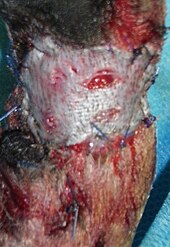
Surgical removal ( resection ) should be carried out as early as possible, i.e. before lymph nodes or even other organs are involved (stage 1). Mast cell tumors have a pseudocapsule made up of compressed tumor cells and usually fine extensions into the surrounding tissue that extend beyond the palpable tumor tissue. For this reason, a safety distance of about 3 cm above the tactile edge is recommended. The removal takes place, even with mast cell tumors in the subcutaneous tissue , with the entire skin and in depth including the subcutaneous fascia . It can be difficult to close the resulting skin defect on the limbs, so that a skin graft may also be necessary. Biopsies should be taken from the margins and the remaining tissue in the depth (tumor bed) to check for the presence of residual tumor tissue .
These basic rules of tumor surgery cannot always be fully implemented, especially on the limbs, because this would result in the loss of nerves , vessels and tendons , so that amputation must also be considered. Under certain circumstances, attempts can be made by using H₁ and H₂ receptor antagonists before the operation to reduce the tumor size. Even if the number of tumor cells is not completely removed to reduce the number of tumor cells ( cytoreductive resection ), the administration of these active substances is indicated, since the intervention can lead to degranulation of the mast cells and thus the release of inflammatory factors.
With well-differentiated mast cell tumors that are smaller than 5 cm, the prospect of healing ( prognosis ) is very good with proper surgical removal, but poor with recurrences . Planning the surgical approach during the initial procedure is therefore of crucial importance. With tumors smaller than 2.5 cm, the survival time is very high even with high-grade tiúmoren.
radiotherapy
The radiation therapy is mainly used not completely removable mast cell tumors as adjunctive therapy and is regarded as a drug of choice. Mast cells are very sensitive to ionizing radiation . In grade 2 mast cell tumors, various studies show disease-free disease in about 95% of patients after one year, and in about 90% of patients between the second and fifth years after treatment. For grade 3 tumors without lymph node involvement, the one-year survival rate in one study was 71%. Radiation therapy can also be used as a palliative treatment , as it usually leads to a significant shrinkage of the tumor. A study on short-distance radiation therapy for tumors of grade 2 and 3 after surgical removal also showed good results and good tolerability.
chemotherapy
For chemotherapy different active ingredients are used. Glucocorticoids have a direct inhibitory effect on the multiplication of mast cells. Direct injection into the tumor is no longer recommended; systemic administration , on the other hand, is often combined with the administration of cytostatics . Vinca alkaloids such as vinblastine , cyclophosphamide , hydroxycarbamide , doxorubicin , mitoxantrone and L-asparaginase are used as cytostatics , although combinations of different active ingredients are more promising.
In one study, hydroxycarbamide responded in 28% of the treated dogs, 4% (two animals) showed complete healing ( complete remission ). Side effects were mainly changes in the blood count such as anemia and neutropenia . The combination of hydroxycarbamide with prednisolone in incompletely removed grade 2 tumors resulted in death from liver failure in two cases ; of the remaining dogs all survived the first and 77% the second year. With the combination of hydroxycarbamide, vinblastine and prednisolone, a response rate of 65% was achieved for mast cell tumors that could not be removed or that could not be completely removed; the mean survival time was significantly higher for grade 2 tumors than for grade 3 tumors (954 versus 190 days). The side effects (neutropenia, increase in liver values ) were moderate.
Tyrosine Kinase Inhibitors

In the meantime, the tyrosine kinase inhibitors are active ingredients that specifically work on the stem cell receptor of the mast cells. Since 2009, two tyrosine kinase inhibitors - masitinib (trade name Masivet ) and toceranib (trade name Palladia ) - have been approved in the EU for the treatment of mast cell tumors in dogs .
Masitinib is approved for the treatment of inoperable mast cell tumors of grade 2 and 3 (or high-grade) with c-KIT mutation. The main side effects are vomiting, diarrhea, neutropenia , anemia and proteinuria , but these are usually mild. In a study on dogs with grade 2 and 3 tumors without metastases, the mean survival time increased from 75 to 118 days when the active ingredient was used for the initial treatment to 253 days.
Toceranib has several points of attack ( multitarget drug ): It acts not only on the stem cell receptor, but also on the receptors for the vascular (VEGF) and platelet growth factor (PDGF) and can therefore also be used in mast cell tumors without c-KIT mutation. The side effects are similar to those of masitinib, but are very common and are serious in over a third of the animals.
There has also been positive experience with the tyrosine kinase inhibitor imatinib, which is approved for human medicine .
Mast cell tumors of other species
Mast cell tumors in humans
| Classification according to ICD-10 | |
|---|---|
| C94.3 | Mast cell leukemia |
| C96.2 | Malignant mast cell tumor Malignant mastocytosis |
| Q82.2 | congenital mastocytosis urticaria pigmentosa |
| ICD-10 online (WHO version 2019) | |
A pathological proliferation of mast cells is called mastocytosis in human medicine . The increased storage of mast cells in the skin ( cutaneous mastocytosis ) is a rare disease with an incidence of less than ten new cases per 1 million population. The most common form of these skin mastocytoses is benign urticaria pigmentosa ("pigment nettle addiction"). Other organs are also affected in around 20% of small children, while the figures for adults vary between 40 and 90%.
Isolated mast cell tumors such as those in dogs are very rare in humans. Benign mast cell tumors ( mastocytoma , mast cell nevus ) usually develop in small children under two years of age and appear as single or multiple, reddish or reddish brown raised spots or nodules on the skin. In response to mechanical stimuli or spontaneously, they can swell like hives ( Darier's sign ) and cause itching . There is no tendency for degeneration or involvement of other organs. Mastocytomas usually regress without treatment, but this can take years. Malignant mast cell tumors ( mast cell sarcomas ) are extremely rare in humans and are controversial as an independent clinical picture.
Mast cell tumors in other animal species
Mast cell tumors are also relatively common in horses, cats and ferrets, but less often than in dogs. In domestic horses , they occur mainly in older animals in the head and neck area as well as on the lower limbs. The recurrence rate is low with proper surgical removal. In domestic cats , mast cell tumors of the skin are mostly benign. A histological grading as in the dog has not proven to be useful. Surgical removal is also the treatment method of choice for cats, and if the resection is incomplete, it can also be combined with radiation. If mast cell tumors are numerous, palliative treatment with glucocorticoids can also be attempted. A special form of mast cell tumor occurs in Siamese cats . Here the mast cells resemble histiocytes and collections of lymphocytes and eosinophilic granulocytes are scattered in the tumor . In older cats, mast cell tumors occasionally develop in the small intestine, which can lead to intestinal invagination or perforation and which exhibit aggressive biological behavior. In ferrets , mast cell tumors make up about 16% of skin tumors, but they are also mostly benign.
Mast cell tumors are very rare in other mammals. There are individual reports on domestic cattle , house donkeys , domestic pigs , llamas , Richardson ground squirrels , hamsters and African hedgehogs . In mice spontaneous mast cell tumors are very rare, in research, the mouse is Masttumor- cell line P 815 but very commonly used.
Mast cell tumors are very rare in birds and reptiles; individual cases have been described in domestic fowl , chain snake and a Galápagos giant tortoise .
Web links
- Martin Kessler: The mast cell tumor in dogs: a tumor with many faces.
- Mast cell tumor - information from the University of Munich
literature
- Martin Kessler : Small animal oncology: diagnosis and therapy of tumor diseases in dogs and cats . 2nd edition, Parey Verlag, Stuttgart 2005, ISBN 978-3-8304-4103-8 , pp. 210-215.
- Martin Kessler: Mast cell tumors, mastocytoma (mast cell sarcoma). In: Hans Georg Nobody, Peter F. Suter (Hrsg.): Internship of the dog clinic. 10th edition, Parey Verlag, Stuttgart 2006, ISBN 978-3-8304-4141-0 , pp. 1135-1136.
- Anthony S. Stannard and L. Thoma Pulley: Mastocytoma of the dog . In: Jack E. Moulton (Ed.): Tumors in domestic animals . 2nd edition, University of California Press, Berkeley [et al.] 1978, ISBN 0-520-02386-2 , pp. 26-31.
- C. Guillermo Couto: Mast cell tumors in dogs and cats. In: Richard W. Nelson and C. Guillermo Couto (Eds.): Small animal internal medicine. 3rd edition, Mosby, St. Louis 2003, ISBN 0-323-01724-X , pp. 1146-1149.
- 55. Österreichische Apotheker-Verlagsgesellschaft mbH: Austria-Codex Schnellhilfe 2016/17. Druckerei Berger, Horn 2016, p. 1015, ISBN 978-3-85200-244-6
Individual evidence
- ↑ a b R. J. Mayoral et al .: MiR-221 influences effector functions and actin cytoskeleton in mast cells. In: PloS one. Volume 6, number 10, 2011, p. E26133, ISSN 1932-6203 . doi: 10.1371 / journal.pone.0026133 . PMID 22022537 . PMC 3192147 (free full text).
- ^ CP Shelburne and JJ Ryan: The role of Th2 cytokines in mast cell homeostasis. In: Immunological Reviews . Volume 179, February 2001, pp. 82-93, ISSN 0105-2896 . PMID 11292031 . (Review).
- ↑ a b S. Ch'ng et al .: Mast cells and cutaneous malignancies. In: Modern Pathology . Volume 19, Number 1, January 2006, pp. 149-159, ISSN 0893-3952 . doi: 10.1038 / modpathol.3800474 . PMID 16258517 . (Review).
- ^ SJ Galli, M. Tsai: Mast cells in allergy and infection: versatile effector and regulatory cells in innate and adaptive immunity. In: European Journal of Immunology. Volume 40, Number 7, July 2010, pp. 1843-1851, ISSN 1521-4141 . doi: 10.1002 / eji.201040559 . PMID 20583030 . (Review).
- ↑ Erwin Dahme and Eugen Weiss: Outline of the special pathological anatomy of domestic animals. 6th edition, Parey Verlag, Stuttgart 2007, ISBN 978-3-8304-1048-5 , p. 143.
- ↑ LA Hillman, et al .: Biological behavior of oral and perioral mast cell tumors in dogs: 44 cases (1996-2006). In: Journal of the American Veterinary Medical Association. Volume 237, Number 8, October 2010, pp. 936-942, ISSN 0003-1488 . doi: 10.2460 / javma.237.8.936 . PMID 20946081 .
- ^ AK Patnaik et al .: Extracutaneous mast-cell tumor in the dog. In: Veterinary pathology. Volume 19, Number 6, November 1982, pp. 608-615, ISSN 0300-9858 . PMID 6815869 .
- ↑ M. Fife et al .: Canine conjunctival mast cell tumors: a retrospective study. In: Veterinary ophthalmology. Volume 14, Number 3, May 2011, pp. 153-160, ISSN 1463-5224 . doi: 10.1111 / j.1463-5224.2010.00857.x . PMID 21521438 .
- ↑ a b c d e Martin Kessler: Mast cell tumors, mastocytoma (mast cell sarcoma). In: Hans Georg Nobody, Peter F. Suter (Hrsg.): Internship of the dog clinic. 10th edition, Parey Verlag, Stuttgart 2006, ISBN 978-3-8304-4141-0 , pp. 1135-1136.
- ^ A b c Anthony S. Stannard and L. Thoma Pulley: Mastocytoma of the dog . In: Jack E. Moulton (Ed.): Tumors in domestic animals . 2nd edition, University of California Press, Berkeley [et al.] 1978, ISBN 0-520-02386-2 , pp. 26-31.
- ↑ a b c d F. Riva et al .: A study of mutations in the c-kit gene of 32 dogs with mastocytoma. In: Journal of veterinary diagnostic investigation. Volume 17, Number 4, July 2005, pp. 385-388, ISSN 1040-6387 . PMID 16131001 .
- ↑ H. Sadrzadeh, O. Abdel-Wahab, AT Fathi: Molecular alterations underlying eosinophilic and mast cell malignancies. In: Discovery medicine. Volume 12, Number 67, December 2011, pp. 481-493, ISSN 1944-7930 . PMID 22204765 .
- ^ Y. Takeuchi et al .: Aberrant autophosphorylation of c-Kit receptor in canine mast cell tumor cell lines. In: Veterinary immunology and immunopathology. Volume 137, Number 3-4, October 2010, pp. 208-216, ISSN 1873-2534 . doi: 10.1016 / j.vetimm.2010.05.009 . PMID 20591500 .
- ↑ K. Ohmori et al .: Identification of c-kit mutations-independent neoplastic cell proliferation of canine mast cells. In: Veterinary immunology and immunopathology. Volume 126, Number 1-2, November 2008, pp 43-53, ISSN 0165-2427 . doi: 10.1016 / j.vetimm.2008.06.014 . PMID 18687474 .
- ↑ a b Heike Aupperle et al .: New diagnostic aspects in canine mast cell tumors - an overview of the current study situation. In: small animal specifically. S1 (2011), pp. 44-48. ( Full text ( memento of August 13, 2012 in the Internet Archive ); PDF; 1.3 MB)
- ↑ MM Welle et al .: Canine mast cell tumors: a review of the pathogenesis, clinical features, pathology and treatment. In: Veterinary dermatology. Volume 19, Number 6, December 2008, pp. 321-339, ISSN 1365-3164 . doi: 10.1111 / j.1365-3164.2008.00694.x . PMID 18980632 . (Review).
- ↑ a b c d e f James Warland and Jane Dobson: Skin tumors in dogs and cats. In: Veterinary Focus. Volume 21, 2011, pp. 34-41.
- ↑ a b c d e Martin Kessler: The mast cell tumor of the dog: a tumor with many faces.
- ↑ a b c d e C. Guillermo Couto: Mast cell tumors in dogs and cats. In: Richard W. Nelson and C. Guillermo Couto (Eds.): Small animal internal medicine. 3rd edition, Mosby, St. Louis 2003, ISBN 0-323-01724-X , pp. 1146-1149.
- ↑ a b c d e f Martin Kessler: Small animal oncology: diagnosis and therapy of tumor diseases in dogs and cats . 2nd edition, Parey Verlag, Stuttgart 2005, ISBN 978-3-8304-4103-8 , pp. 210-215.
- ↑ Reinhard Mischke: Cytological internship for veterinary medicine . Schlütersche, Hannover 2005, ISBN 978-3-89993-013-9 , p. 135.
- ^ AK Patnaik, WJ Ehler, EG MacEwen: Canine cutaneous mast cell tumor: morphologic grading and survival time in 83 dogs. In: Veterinary pathology. Volume 21, Number 5, September 1984, pp. 469-474, ISSN 0300-9858 . PMID 6435301 .
- ↑ a b M. Kiupel et al .: Proposal of a 2-tier histologic grading system for canine cutaneous mast cell tumors to more accurately predict biological behavior. In: Veterinary pathology. Volume 48, Number 1, January 2011, pp. 147-155, ISSN 1544-2217 . doi: 10.1177 / 0300985810386469 . PMID 21062911 .
- ↑ RM Gil da Costa et al .: CD117 immunoexpression in canine mast cell tumors: correlations with pathological variables and proliferation markers. In: BMC veterinary research. Volume 3, 2007, p. 19, ISSN 1746-6148 . doi: 10.1186 / 1746-6148-3-19 . PMID 17711582 . PMC 2077863 (free full text).
- ↑ D. Zemke, B. Yamini, V. Yuzbasiyan-Gurkan: Mutations in the juxtamembrane domain of c-KIT are associated with higher grade mast cell tumors in dogs. In: Veterinary pathology. Volume 39, Number 5, September 2002, pp. 529-535, ISSN 0300-9858 . PMID 12243462 .
- ↑ a b J. J. Thompson et al .: Canine subcutaneous mast cell tumors: cellular proliferation and KIT expression as prognostic indices. In: Veterinary pathology. Volume 48, Number 1, January 2011, pp. 169-181, ISSN 1544-2217 . doi: 10.1177 / 0300985810390716 . PMID 21160022 .
- ↑ a b M. N. Mayer: Radiation therapy for canine mast cell tumors. In: The Canadian veterinary journal. La revue vétérinaire canadienne. Volume 47, Number 3, March 2006, pp. 263-265, ISSN 0008-5286 . PMID 16604985 . PMC 2823470 (free full text). (Review).
- ↑ M. Fife et al .: Canine conjunctival mast cell tumors: a retrospective study. In: Veterinary ophthalmology. Volume 14, Number 3, May 2011, pp. 153-160, doi : 10.1111 / j.1463-5224.2010.00857.x , PMID 21521438 .
- ↑ AS Moore et al .: Retrospective outcome evaluation for dogs with surgically excised, solitary Kiupel high ‐ grade, cutaneous mast cell tumors. In: Vet. Comp. Oncol. 2020. doi: 10.1111 / vco.12565
- ^ NC Northrup, RE Roberts, TW Harrell, KL Allen, EW Howerth, TL Gieger: Iridium-192 interstitial brachytherapy as adjunctive treatment for canine cutaneous mast cell tumors. In: Journal of the American Animal Hospital Association. Volume 40, Number 4, 2004 Jul-Aug, pp. 309-315, ISSN 1547-3317 . PMID 15238561 .
- ↑ SM Govier: Principles of treatment for mast cell tumors. In: Clinical techniques in small animal practice. Volume 18, Number 2, May 2003, pp. 103-106, ISSN 1096-2867 . doi: 10.1053 / svms.2003.36624 . PMID 12831070 . (Review).
- ↑ KM Rassnick et al .: Phase II open-label study of single-agent hydroxyurea for treatment of mast cell tumors in dogs. In: Veterinary and comparative oncology. Volume 8, Number 2, June 2010, pp. 103-111, ISSN 1476-5829 . doi: 10.1111 / j.1476-5829.2010.00211.x . PMID 20579323 .
- ↑ K. Hosoya et al .: Adjuvant CCNU (lomustine) and prednisone chemotherapy for dogs with incompletely excised grade 2 mast cell tumors. In: Journal of the American Animal Hospital Association. Volume 45, Number 1, 2009 Jan-Feb, pp. 14-18, ISSN 1547-3317 . PMID 19122059 .
- ↑ KM Rassnick et al .: A phase II study to evaluate the toxicity and efficacy of alternating CCNU and high-dose vinblastine and prednisone (CVP) for treatment of dogs with high-grade, metastatic or nonresectable mast cell tumors. In: Veterinary and comparative oncology. Volume 8, Number 2, June 2010, pp. 138-152, ISSN 1476-5829 . doi: 10.1111 / j.1476-5829.2010.00217.x . PMID 20579327 .
- ^ Österreichische Apotheker-Verlagsgesellschaft mbH: Austria-Codex Schnellhilfe 2016/17 . Ed .: Österreichische Apotheker-Verlagsgesellschaft mbH Vienna 2016, ISBN 978-3-85200-244-6 , p. 1015 .
- ↑ Product information for Palladia film-coated tablets for dogs. (PDF) Retrieved January 2, 2017 .
- ^ KA Hahn et al .: Masitinib is safe and effective for the treatment of canine mast cell tumors. In: Journal of veterinary internal medicine Volume 22, Number 6, 2008 Nov-Dec, pp. 1301-1309, ISSN 0891-6640 . doi: 10.1111 / j.1939-1676.2008.0190.x . PMID 18823406 .
- ↑ entry to Toceranib at Vetpharm, accessed on 29 July 2012 found.
- ↑ O. Yamada et al .: Imatinib elicited a favorable response in a dog with a mast cell tumor carrying a c-kit c.1523A> T mutation via suppression of constitutive KIT activation. In: Veterinary immunology and immunopathology. Volume 142, Number 1-2, July 2011, pp. 101-106, ISSN 1873-2534 . doi: 10.1016 / j.vetimm.2011.04.002 . PMID 21561667 .
- ↑ Guideline Mastocytosis (PDF; 313 kB) of the German Dermatological Society
- ^ Heiko Traupe, Henning Hamm: Pediatric Dermatology . 2nd edition, Springer, Heidelberg 2005, ISBN 978-3-540-25646-5 , pp. 215-223.
- ↑ a b Gerd Plewig, P. Thomas: Advances in practical dermatology and venereology 2006 . Volume 20 of Advances in Practical Dermatology and Venereology . Springer, Heidelberg 2007, ISBN 3-540-30514-9 , p. 391.
- ↑ Otto Braun-Falco et al .: Dermatology and Venereology . 5th edition, Springer, Heidelberg 2005, ISBN 978-3-540-40525-2 , p. 1396.
- ↑ Wolfgang Remmele: Pathology. 1. Legal issues in pathology; Introduction to biopsy diagnostics; Heart and vascular system; Hematology; Spleen; Thymus . 2nd edition, Springer, Berlin 1999, ISBN 3-540-61095-2 , pp. 507-508.
- ↑ Hanns-Jürgen Wintzer: Diseases of the horse: a guide for study and practice. 3rd edition, Parey, Berlin 1999, ISBN 3-8263-3280-6 , p. 483.
- ↑ Laura Marconato and Giuliano Bettini: Colon tumors in cats. In: Veterinary Focus 23 (2013), pp. 39-45.
- ↑ GA Parker, CA Picut: Histopathologic features and post-surgical sequelae of 57 cutaneous neoplasms in ferrets (Mustela putorius furo L.). In: Veterinary pathology. Volume 30, Number 6, November 1993, pp. 499-504, ISSN 0300-9858 . PMID 8116142 . (Review).
- ^ BI Smith and LA Phillips: Congenital mastocytomas in a Holstein calf. In: The Canadian veterinary journal. Volume 42, Number 8, August 2001, pp. 635-637, ISSN 0008-5286 . PMID 11519274 . PMC 1476568 (free full text).
- ↑ G. Kay et al .: Grade III mastocytoma in a donkey. In: The Veterinary Record. Volume 152, Number 9, March 2003, pp. 266-267, ISSN 0042-4900 . PMID 12638914 .
- ↑ G. Migaki, KA Langheinrich: Mastocytoma in a pig. In: Pathologia veterinaria. Volume 7, Number 4, 1970, pp. 353-355, ISSN 0031-2975 . PMID 4998946 .
- ↑ TY Lin et al .: Mast cell tumors in a llama (Lama glama). In: Journal of veterinary diagnostic investigation. Volume 22, Number 5, September 2010, pp. 808-811, ISSN 1040-6387 . PMID 20807950 .
- ↑ XJ He et al .: Spontaneous cutaneous mast cell tumor with lymph node metastasis in a Richardson's ground squirrel (Spermophilus richardsonii). In: Journal of veterinary diagnostic investigation. Volume 21, Number 1, January 2009, pp. 156-159, ISSN 1040-6387 . PMID 19139521 .
- ↑ K. Nishizumi, K. Fujiwara, A. Hasegawa: Cutaneous mastocytomas in Djungarian hamsters. In: Experimental animals. Volume 49, Number 2, April 2000, pp. 127-130, ISSN 1341-1357 . PMID 10889951 .
- Jump up ↑ JT Raymond, MR White, EB Janovitz: Malignant mast cell tumor in an African hedgehog (Atelerix albiventris). In: Journal of wildlife diseases. Volume 33, Number 1, January 1997, pp. 140-142, ISSN 0090-3558 . PMID 9027702 .
- ^ DJ Lewis, JM Offer: Malignant mastocytoma in mice. In: Journal of comparative pathology. Volume 94, Number 4, October 1984, pp. 615-620, ISSN 0021-9975 . PMID 6439762 .
- ↑ GM Patnaik, D. Mohanty: A case of avian mastocytoma. In: The Indian veterinary journal. Volume 47, Number 4, April 1970, pp. 298-300, ISSN 0019-6479 . PMID 4987390 .
- ↑ J. Schumacher, RA Bennett, LE Fox, SL Deem, L. Neuwirth, JH Fox: Mast cell tumor in an eastern kingsnake (Lampropeltis getulus getulus). In: Journal of veterinary diagnostic investigation. Volume 10, Number 1, January 1998, pp. 101-104, ISSN 1040-6387 . PMID 9526872 .
- ↑ M. Santoro et al .: Mast cell tumor in a giant Galapagos tortoise (Geochelone nigra vicina). In: Journal of comparative pathology. Volume 138, Number 2-3, 2008 Feb-Apr, pp. 156-159, ISSN 0021-9975 . doi: 10.1016 / j.jcpa.2007.11.004 . PMID 18308330 .

